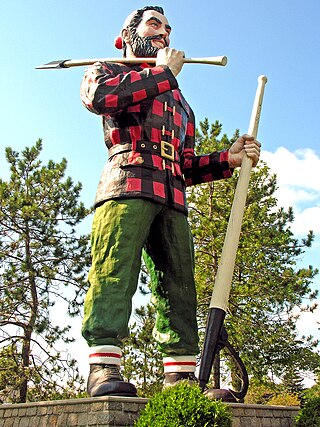
Paul Bunyan is a giant lumberjack and folk hero in American and Canadian folklore. His tall tales revolve around his superhuman labors, and he is customarily accompanied by Babe the Blue Ox, his pet and working animal. The character originated in the oral tradition of North American loggers, and was later popularized by freelance writer William B. Laughead (1882–1958) in a 1916 promotional pamphlet for the Red River Lumber Company. He has been the subject of various literary compositions, musical pieces, commercial works, and theatrical productions. His likeness is displayed in a number of oversized statues across North America.
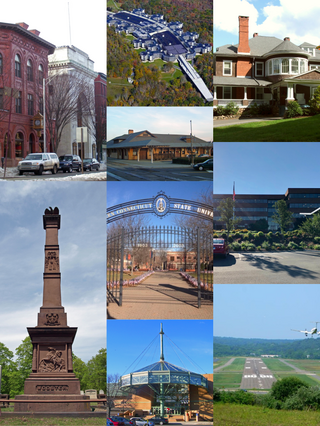
Danbury is a city in Fairfield County, Connecticut, United States, located approximately 50 miles (80 km) northeast of New York City. Danbury's population as of 2020 was 86,518. It is the third-largest city in Western Connecticut, and the seventh-largest city in Connecticut. Located within the heart of the Housatonic Valley region, the city is a commercial hub of western Connecticut, an outer-ring commuter suburb of New York City, and an historic summer colony of the New York metropolitan area and New England.

The 1939 New York World's Fair was an international exposition at Flushing Meadows–Corona Park in Queens, New York City, United States. The fair included exhibitions, activities, performances, films, art, and food presented by 62 nations, 35 U.S. states and territories, and 1,400 organizations and companies. Slightly more than 45 million people attended over two seasons. It was based on "the world of tomorrow", with an opening slogan of "Dawn of a New Day". The 1,202-acre (486 ha) fairground consisted of seven color-coded zones, as well as two standalone focal exhibits. The fairground had about 375 buildings.

The Seattle Art Museum is an art museum located in Seattle, Washington, United States. The museum operates three major facilities: its main museum in downtown Seattle; the Seattle Asian Art Museum in Volunteer Park, Capitol Hill; and Olympic Sculpture Park on the central Seattle waterfront, which opened in 2007.
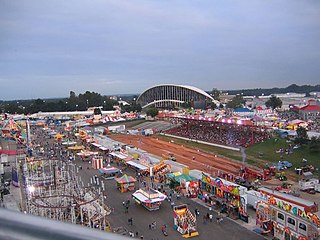
The North Carolina State Fair is an American state fair and agricultural exposition held annually in Raleigh, North Carolina. Founded in 1853, the fair is organized by the North Carolina Department of Agriculture and Consumer Services. It attracts around a million visitors over eleven days in mid-October.
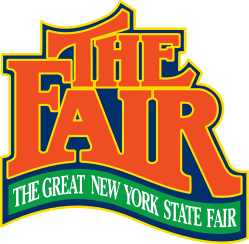
The New York State Fair, also known as the Great New York State Fair, is a 13-day showcase of agriculture, entertainment, education, and technology. With midway rides, concessionaires, exhibits, and concerts, it has become New York's largest annual event and an end-of-summer tradition for hundreds of thousands of families from all corners of the state. The first fair took place in Syracuse in 1841, and took permanent residence there in 1890. It is the oldest and one of the largest state fairs in the United States, with over one million visitors annually.

The Orange County Fair, abbreviated as the OC Fair, is a 23-day annual fair that is held every summer at the OC Fair & Event Center in Costa Mesa, California. The 2024 OC Fair was held from July 19 to August 18, and the theme was “Always a Good Time!”
The OC Fair & Event Center (OCFEC) is a 150-acre (0.61 km2) event venue in Costa Mesa, California. The site hosts over 150 events attracting 4.3 million visitors annually, and is home to the Orange County Fair, Centennial Farm, Costa Mesa Speedway, and Pacific Amphitheatre.
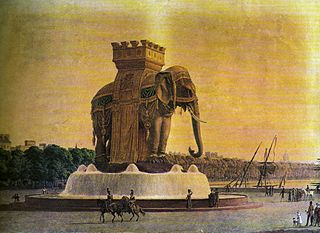
Novelty architecture, also called programmatic architecture or mimetic architecture, is a type of architecture in which buildings and other structures are given unusual shapes for purposes such as advertising or to copy other famous buildings. Their size and novelty means that they often serve as landmarks. They are distinct from architectural follies, in that novelty architecture is essentially usable buildings in eccentric form whereas follies are non-usable, purely ornamental buildings also often in eccentric form.
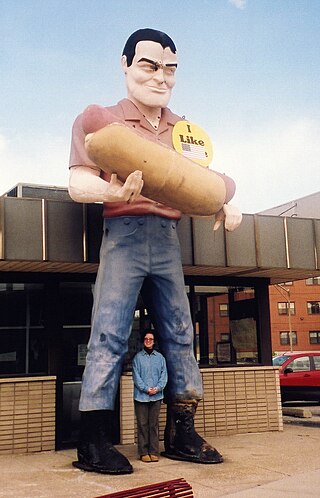
Muffler men are large molded fiberglass sculptures that are placed as advertising icons, roadside attractions, or for decorative purposes, predominantly in the United States. Standing approximately 18–25 ft (5.5–7.6 m) tall, the first figure was a Paul Bunyan character designed to hold an axe. Derivatives of that figure were widely used to hold full-sized car mufflers, tires, or other items promoting various roadside businesses.
There are a number of statues of Paul Bunyan on display in the United States.

Fairground Park is a municipal park that opened in 1908 in St. Louis, Missouri. It was originally a privately owned facility, first used by the St. Louis Agricultural and Mechanical Association for the St. Louis Exposition from 1856 through 1902. However, the Civil War interrupted the annual fair when the Fairgrounds were used as a Union encampment known as Benton Barracks. The annual exposition ceased in 1902 as preparations for the 1904 World's Fair began.

Lake George Expedition Park is an amusement park located in Lake George, New York, United States along Route 9. It opened in 2019, and incorporates the Magic Forest, which opened in 1963, along with a new attraction entitled Dino Roar Valley.

Uncle Beazley is a life-size fiberglass statue of a Triceratops by Louis Paul Jonas. It is located near Lemur Island in the National Zoological Park in Northwest Washington, D.C., United States.

Paul Bunyan Statue is a 31-foot-tall (9.4 m) concrete and metal sculpture of mythical logger Paul Bunyan in the Kenton neighborhood of Portland, Oregon, United States. It was built in 1959 to commemorate the centennial of Oregon's statehood during the Centennial Exposition and International Trade Fair, which was held in the Kenton area.

The butter cow has been an Iowa State Fair staple since 1911, when J.K. Daniels created the first cow. The popular exhibition, which consists of hundreds of pound of local butter applied to a wood and metal wireframe, is showcased in the coolers of the fairground's Agricultural Building.

The Grand Circuit, also known as the "Big Wheel", is a group of harness racing stakes races run at various race tracks around the United States. Run on one-mile tracks, it is "the oldest continuing horse-racing series in the United States."

Richard F. Kishel was an American Marine Corps veteran, Ball State University professor, entrepreneur and artist. The Minnesota native settled in Indiana after his education in Minnesota, Michigan and Iowa.
















